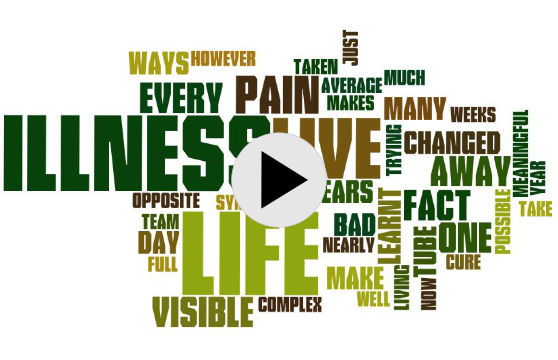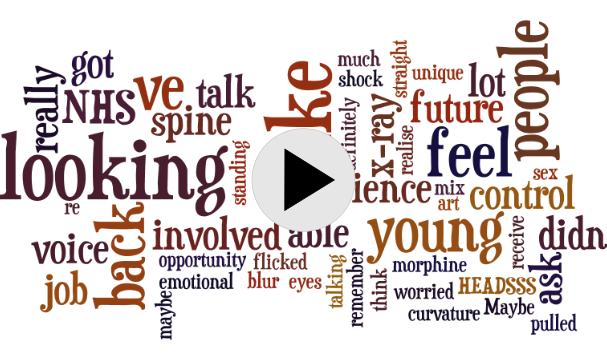Introduction
The same communication skills that help young people to socialise, make friends, maintain friendships and develop positive relationships with others, are an essential part of navigating the health care system and successfully making the healthcare transition journey from young peoples’ services to adult services.
Effective communication skills will benefit young people in their engagements with professionals, carers, parents and peers, making all of those professional and personal relationships more effective and rewarding. We hope that this module will encourage good and meaningful conversations between young people and their clinical teams and prepare parents for the process.
What we'll be covering
We will be looking at the following topics:
- why good communication matters
- improving communication and conversations (for clinicians), including active listening and body language
- Life skills and long-term conditions
- Tricky conversations
We will also:
Why good communication matters
Speaking and Listening are at the heart of life and that includes healthcare.
As children grow into young people and then into adulthood, the conversations change.
It is a learning process for all involved: the clinicians, the young people, their parents – who talks about what, how, when and with whom!?
When good communication does not happen, things can be left unsaid, misunderstandings happen and sometimes conflict starts.
When we get it right, each of us in the conversation feels heard and respected. Good communication will allow good relationships to be built between young people, parents or carers and healthcare teams.
Having tricky conversations
This short film highlights the challenges – and the importance – of having these delicate conversations and invites viewers to think about what they can do to initiate them.
Improving communication and conversations (for clinicians)
Young people often express that they do not feel listened to – this is as true of healthcare as in other areas of their lives. Space, time and the assurance of confidentiality will all help to create an environment where young people feel able to speak up and, when they are ready, to have a conversation without the parent present.
Good communication relies on trust and a rapport, that is a friendly understanding, between participants. A warm and welcoming tone of voice, appropriate language, good use of facial expressions, active listening, effective body language (such as leaning forward in your chair, nodding your head), respect and consideration of the young person’s position and needs are all important elements in establishing good communication.
Active listening
It is important to show the young person that they are being listened to by practising active listening and giving them plenty of time and space to express themselves.
But what does this really mean?
Passive listening would be hearing what someone is saying, but not responding to what is being said, maybe because you are looking at a computer screen or dashing off a prescription.
Active listening, on the other hand has been described as ‘listening on purpose’ and ‘listening to understand’. Here are some of characteristics of active listening:
- responding verbally and non-verbally to show you are listening and understanding
- choosing not to speak or interrupt while the other person is talking
- being non-judgemental, not offering solutions or suggestions and giving the speaker time to feel heard in an unhurried way.
The skills needed for active listening are:
- preparation (stopping other tasks and creating the mental, physical and emotional space to listen)
- using open-ended questions, such as ‘why?’ or ‘how?’ or ‘can you tell me more about that?’ which encourage young people to talk, rather than simply answering ‘yes’ or ‘no’ or ‘don’t know’
- paraphrasing, which means repeating back what you have heard to the speaker in your own words. This shows that you are paying attention and understanding.
- reflecting feelings, which means acknowledging and expressing empathy, for example ‘it sounds like that was very upsetting for you’ or ‘I get a sense that you feel overwhelmed by what has been happening’.
If you’d like to learn more about active listening, check out the website for the Berkeley Well-Being Institute.
Body language – it’s not just the voice
Speaking and listening are fundamental to communication, but body language adds another dimension. Eye contact, expressions, gestures, posture and the way we move all speak volumes.
Non-verbal behaviours can help build trust and support communication. However, they can also result in the opposite and cause tension, discomfort or confusion. For example, having a conversation while sitting behind a desk and computer, is not demonstrating active listening!
Differences in communication
For all involved in the conversation it is important to appreciate differences in communication styles, which may be the result of age (young people and older people tend to have different communication styles); culture, how we are feeling (if we have a headache or are preoccupied with something going on at home, we are likely to be less responsive) simply personality (some people are naturally quiet while others are naturally garrulous) and language issues – if English is not the first language, for example, it is important to consider the use of an interpreter.
Other factors that need to be considered include visual or hearing impairments, learning disability, neurodiversity (including autistic spectrum disorder), behavioural or emotional difficulties.
Life skills and long-term conditions
When talking to Young People with Long Term Conditions about ‘healthcare transition’, they told us they disliked the use of ‘long-term’. They were perfectly aware their condition wasn’t going to go away and calling it ‘long term’ was needlessly rubbing it in. Many young people also describe a lot of unsatisfactory conversations relating to their health and care.
Their perspective on preparing for transition differed from the traditional approach to ‘handing over’ to adult services. The issue for many Young People is about getting on with life, which is difficult enough without the added complication of having a medical condition. The real challenge is gaining those generic life skills that add to chances of success in any endeavour, including conversations about healthcare.
Some of these generic life skills are:
- knowing yourself and being seen for who you are
- being skilful at tricky conversations (difficult conversations, negotiation, feedback etc.)
- understanding risk and consequences
- learning from experience
- developing resilience.
Tricky conversations
It’s important for young people, as well as healthcare professionals and parents, to feel confident about handling tricky conversations, , such as those about sex, drugs, mental health, concordance with treatment, problems at home or in school, etc.
Young people
As you start to take on more responsibility for your health and make more decisions about how you want to live your life, you may find yourself having some pretty difficult conversations with the people in your life. These may be with healthcare workers who disagree with a decision you want to make about your care, or with parents who don’t think you’re quite ready to make those decisions, or even with friends who might not understand what your condition means. But not every tricky conversation has to end in frustration and hurt feelings. Disagreements are natural in all areas of life and can often help us to explore misunderstandings and reach positive solutions.
Here are some tips that might help you avoid a row, or help other people hear where you’re coming from.
- Think about what you want to say first.
A tricky conversation can be even trickier if you’re not sure what you want to say. Try taking five minutes to write down or record what you want to say and how you want to say it before you start your conversation. Think about how whatever you want to talk about affects you and your life, how it makes you feel, and how you want to bring up the topic. You can also practice having the conversation with a friend before having a go at the real thing.
- Find out the other person’s views, feelings, and concerns first.
Once you’re ready to talk, start by getting a sense of what the other person thinks. Say you want to talk to a new friend about your condition; asking them what they already know – or think they know – can help you ease into a tricky conversation. Plus, you can’t help ease their worries or concerns if you don’t know what they are.
- Express your views and opinions.
Explain where you’re coming from clearly and calmly; this is where thinking the conversation through first will help.
- Let people know that you are more than just your condition.
You might like to draw a paint a picture, write a poem or find some other creative means of letting other people to know who you are, your hopes, dreams and aspirations so that they can see you as a whole person.
- Figure out where to go next – together.
Once you’ve both said how you feel and what you would like to happen, you can work on a resolution, a solution, or a way ahead, one step at a time.
Saying the unsaid
This short film illustrates different perspectives about some of the more challenging areas to speak about. It also includes an explanation of the HEADSSS assessment.
Health professionals
Here are a few tips to help make conversations with young people flow more easily.
- See the person not the condition
Many young people have described how they believe their professional caregivers only see their condition, not the person they are and aspire to be. This means that they don’t feel their care is personalized and they feel less inclined to believe it is tailored for their particular needs. You might like to encourage young people in your care to develop a simple, clear way of describing themselves (e.g. a collage or video or picture montage) that they could use to help their clinicians get to know them.
- Learning to take risks safely
Most adults have taken risks in their youth, and many continue to do so as adults (smoking, drinking and driving, unprotected sex are not unique to YP!) However, there are additional levels of risk when you have a medical condition. If Young People understand the issues that allow them to reduce unnecessary risks, they are more likely to make wise decisions.
This brief clip illustrates this issue:
The Better Conversations co-produced films
Intro film
A life not a disease
Lived experience
Stories are a powerful way of learning and can help put your learning into context.
Watch or listen to the stories below and think about how they relate to the material in this module.
An invisible illness
A bright future
Summary
Hopefully you now feel more confident to have better conversations in health and care.
As a young person, this means thinking and planning what matters to you, what you want to talk about and speaking up when you have the opportunity.
As a parent or carer, this means, supporting your child in learning how to speak to healthcare teams more and more independently, giving them the space to have conversations by themselves.
As a clinician and as healthcare teams, this means creating space and opportunity for better conversations with the young person and helping them with tricky conversations by making them less tricky.
If you want to know more...
There are plenty of ways to find out more. One great one is to use your NHS account to access services online on your computer, tablet or mobile phone.
Find more information on the 11to25hub
Why not dip into one of our other modules, where you can find out about other aspects of healthcare transition in more detail.
Bust the jargon!
Whether you’re a young person, a parent or a professional you’ll have realised that there’s a lot of jargon in the health and social care systems. This jargon buster from Think Local Act Personal may help. Just type in a term…
External resources
Here are some more resources that you may find helpful, engaging and informative:
- Youth Employment UK believe that communication is an important life and work skill, and so it’s important to understand What are Communication Skills?
- It’s good to think about your verbal and non-verbal communication with young people, and YERP has some useful tips on Communicating with Young People
- BBC Bitesize has great stuff on the functional skills of communication, including on Listening, interrupting politely and moving things on , Knowing when to use formal or informal language, and Asking questions, being clear and persuading people
- Not got much time? ActiveBeat has a four-minute read on Easy Steps to More Effective Communication
- It’s not just about adults talking to young people – conversations go two ways. YoungPost has some great tips in How to talk to adults 101
- It’s not always easy to work out who to talk to. Here are some tips and hints from SeeMe about Talking to adults.
How useful was this page?
Click on a star to rate it!
Average rating 4.9 / 5. Vote count: 8



